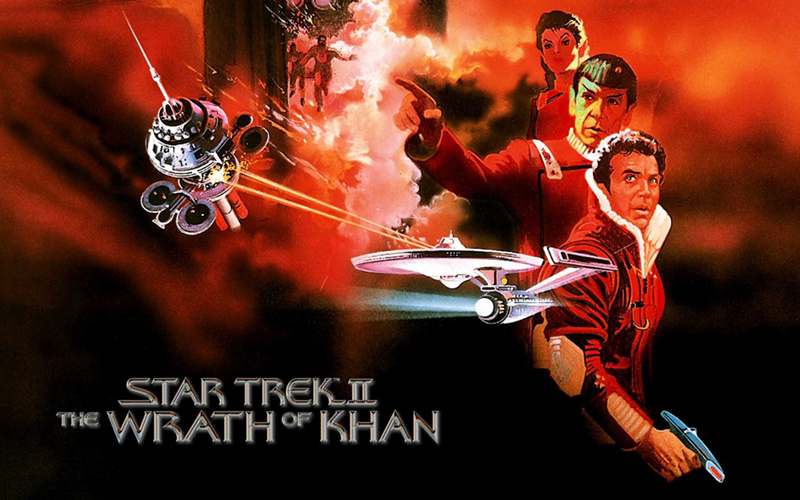Retro Review: Star Trek: The Motion Picture
8 min readAs the refurbished Enterprise under the command of Captain Decker prepares for launch, Admiral Kirk learns of a threat to Earth and summons his old crew for assistance.
Plot Summary: An unknown entity destroys several Klingon ships, then a Federation space station. Meanwhile, on Vulcan, Spock is about to enter the final stage of Kolinahr – the purging of all emotion – but the entity stirs Spock’s emotions, forcing Spock to seek his answers elsewhere. On Earth, the newly refurbished Enterprise is preparing for launch when Admiral Kirk learns that the destructive entity is approaching. He takes over command of the ship from Captain Will Decker, whose onetime lover, Lieutenant Ilia, has become the navigator. Kirk requests that Dr. McCoy be called out of retirement to join Dr. Chapel in Sickbay and, after losing the new science officer in a transporter accident, welcomes Spock aboard. Though his former shipmates reach out to him, Spock’s only interest is in discovering the purpose of the entity, which overwhelms the ship’s scans and weapons systems, then sends a probe that downloads the ship’s computer data before vanishing along with Ilia. Shortly afterward, the probe returns in Ilia’s form, introducing the alien entity as “V’Ger” and stating that its purpose in approaching Earth is to find its creator. Kirk asks Decker to try to bring out the probe’s memories of life as Ilia. While he does so, Spock takes a thruster suit and leaves the ship to try to reach the center of the vast machinery of V’Ger, but when he tries to mind-meld with V’Ger, his own mind is overwhelmed by the loneliness of the vast machine. Soon afterward, V’Ger reaches Earth and launches energy weapons that Ilia says will eradicate all carbon-based life on Earth so that V’Ger’s creator – which V’Ger assumes to be a machine – can respond to its hails. Kirk insists that he can respond to V’Ger and is taken, along with Spock, McCoy, Decker, and Ilia, to the center of the machinery. There, the officers realize that V’Ger is in fact Voyager 6, an old Earth vessel built to gather information to return to its creator. Voyager 6 vanished into a black hole, from which it apparently emerged on the other side of the galaxy, where a planet of machines took its programming literally and redesigned it to amass all possible knowledge to bring back to Earth. The Enterprise tries to transmit the code to tell Voyager to transmit its information, but V’Ger burns out its own circuits to force the creator to come personally. Spock hypothesizes that V’Ger has developed consciousness and needs to evolve to find a new purpose. Guessing that only direct contact will allow V’Ger to achieve its goal, Decker touches the circuitry to key in the code, then merges with V’Ger and with Ilia to create a non-corporeal life form. Moved by the experience, Spock says he has no need to return to Vulcan, and Kirk orders the ship “out there, thataway.”
Analysis: A note: I own the Director’s Edition, so that’s what you’re getting summarized here. And a word of warning: this review is even more personal than most of my reviews. If you want an objective analysis of Star Trek: The Motion Picture, I can give it to you in a sentence: “Overlong, poorly edited, stiffly acted, with too much focus on the guest actors and special effects, too little of the elements that made most people appreciate Star Trek as a television series.” That’s the review pretty much everyone expects, because pretty much everyone with whom I’ve discussed it was disappointed by Star Trek: The Motion Picture. After years of fan anticipation, Paramount gave us barely-recognizable characters, boring sequences showing off the new Enterprise, minimal action, visual effects that couldn’t rival Star Wars, colorless new costumes and sets, and a silly ending that tossed out the scientific progress for which Star Trek had always stood. Plus, it was increasingly obvious that the entire cast was aging and Shatner wore a toupee. The soundtrack and sound mixing were generally praised, but the rest of the film was written off as a bad relaunch, overshadowed by the rest of the original series movies.
Those aren’t the things I usually remember about The Motion Picture, however. For me, this is the movie in which Spock tells Kirk that he loves him. Everyone who reads my reviews regularly knows that I have a sordid history with fan fiction, which was, at the time of this film’s release, being passed around under the name from which the slash genre adopted its label. But I was only 12 years old then, and though K/S already existed, I was unaware of it until Gene Roddenberry wrote in the novelization of this movie the most famous footnote in fannish history. First Roddenberry defined the Vulcan expression t’hy’la, which, as Roddenberry explained, can mean “friend,” “brother,” and “lover,” and which was the word Spock used to describe his relationship with Kirk. It’s worth quoting the rest of Roddenberry’s footnote in full, because it had such a profound impact not just on the way I watch Star Trek and all other forms of entertainment, but on how I thought about gay people, gay rights, even how I define my own sexual identity:
[Spock] did indeed consider Kirk to have become his brother. However, because “t’hy’la” can be used to mean “lover” and since Kirk’s and Spock’s friendship was unusually close, this has led to some speculation over whether or not they had actually indeed become lovers. At our request, Admiral Kirk supplied the following comments on this subject: “I was never aware of this ‘lovers’ rumor, although I have been told that Spock encountered it several times. Apparently, he had always dismissed it with his characteristic lifting of his right eyebrow, which usually connoted some combination of surprise, disbelief, and/or annoyance. As for myself… I have always found my best gratification in that creature called woman. Also, I would not like to be thought of as being so foolish that I would select a love partner who came into sexual heat only once every seven years.”
Over the course of several misogynistic rants about fan fiction, “Trouble With Tribbles” writer David Gerrold has announced that this footnote was Roddenberry’s attempt to stop the slash. I find this amusing, because for me, this footnote started slash as a matter for serious inquiry. Even now, it puts a huge smile on my face, for there’s no denial in here at all – quite the opposite. It confirms that there are good reasons people might have thought Kirk and Spock were in love, demonstrates the pervasiveness of that belief, and suggests that if Kirk can say where he finds his “best” gratification, he’s probably done some experimenting…quite a bit of experimenting, if his behavior during the original five year mission is any indication. What struck me as a twelve year old, both watching this film and reading this footnote, was that the creator of Star Trek thought love between two men – not necessarily sexual, but the primary source of intimacy in both their lives – was normal and acceptable. It’s hard to explain now how completely this perspective differed from anything I’d encountered elsewhere in my life. Of all the things I took away from Star Trek as a child – a reverence for science, a love of exploration, a hatred for prejudice, a belief in the inherent goodness of humanity – this may be the one that had the biggest impact on me at a personal, emotional level.
So it doesn’t bother me that, at the core, Star Trek: The Motion Picture is a cheesy romance in which Persis Khambatta’s exotic beauty is exploited and humankind’s greatest vehicle of exploration only wants to prove that God exists by finding and merging with its creator-father. It all contributes to a view of the universe in which every form of love is a cause for celebration, even the ones that are technically taboo (which means, hilariously, that the heterosexual couple of Decker and Ilia aren’t supposed to consummate their feelings because her species is so hypersexed, not that Kirk and Spock aren’t supposed to hold hands and snuggle in sickbay).
Even the worst aspects of this film are all about nostalgia, the most sentimental form of love, like the endless sequence in which Scotty takes Kirk around the exterior of the new Enterprise to show off the ship to him and to the audience. We get glimpses of Christine Chapel and Janice Rand, the latter finally with a substantive job; we get McCoy making precisely the same jokes at Spock’s expense that he’d have made on the TV series (“Spock, you haven’t changed a bit, you’re just as warm and sociable as ever”). Sulu gets to count the ascending warp speeds; Chekov gets to scream. Uhura gets lots to do compared to, oh, the entire third season of the show, but of course there are hailing frequencies to open, too. Since I watched the extended edition, I got to see Spock crying on the bridge over V’Ger’s (and his own) loneliness, but even without that crazy un-Vulcan ’70s pop psych moment, the plot of ST:TMP, such as it is, is all about feelings over logic. And I can’t even dislike it for that.
Though the movie comes down on the side of insight being greater than science, it also suggests that great knowledge must be amassed before spiritual wisdom can be attained, something with which Kabbalists and Sufis would agree. Somewhere along my travels in Trekdom, I read an analysis of Spock’s journey through V’Ger, speculating that the concentric circles and lights and chambers represent everything from womb/childbirth/emergence to the levels of Paradise a la Dante, but I have no deep analysis of that sort. My pleasures are more personal, perhaps more superficial, but I think it takes an awful stretch to read that level of spiritual significance into a design that I suspect had far more to do with wanting an Academy Award for visual effects. I adore the scene in which Kirk figures out that V’Ger is Voyager 6 – something we made, something we therefore know how to touch/console/satisfy – and everything I dislike about poor Decker’s tantrum-y character is instantly erased when he decides to take the leap to merge with V’Ger, to transcend what his father did in ramming himself and a starship down the Doomsday Machine’s maw. Disappointment perhaps, but the happy ending left things set up for The Wrath of Khan – one of Star Trek’s finest hours (well, two hours) – and a Spock who would ever after call Kirk “Jim” in public. So what’s not for me to love?






